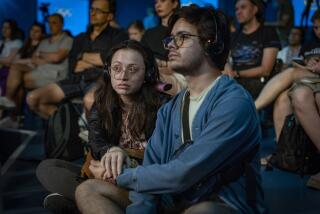Art at the Barricades : Artist Captures Freedom’s Face During Moscow Siege
MOSCOW — Through the terrifying hours of the siege on democracy here last week, Mikhail N. Romadin, with pen or paintbrush in hand, captured the drama and emotion of the people’s resistance on large white poster board.
“I just went there like everyone else--to see what was happening,” Romadin, 50, said. “But then I saw that the most beautiful faces of Moscow, faces longing for freedom, had converged at the Parliament. I was compelled to depict them in my paintings.”
As soon as Romadin and his wife arrived at the Russian Parliament, where volunteers were frantically raising barricades and organizing unarmed defense squads, his wife Viktoria Dukhina said:
“Misha, don’t you think that morally you have to paint this?,” the artist’s wife recalled asking her husband as they took in the scene at the building known as the White House because of its gigantic white stone facade.
“We immediately ran back to our home, which is nearby, and I grabbed my camera and Misha grabbed pens, brushes, colors and paper,” she added.
Throughout the rainy daylight hours of the three-day putsch, Romadin soaked in the images of thousands of “people’s warriors” and poured them through his pens and watercolors onto paper in front of him. Crowds gathered around the bearded, blue jeans-clad artist to watch him catch the emotion of the moment on his easel with bold stokes of his pen or brush.
The seven large works he created during these critical days of his country’s history capture in vivid colors the faces at the barricade: young soldiers who had broken ranks and stood with their tanks to support their people; long-haired rockers, wearing jeans and crosses, who were on the front lines of defense when the tanks closed in; and clean-cut college and high school students perched atop barricades.
“I wanted to portray the emotion of this tense but proud time,” Romadin recalled. “There were lots of photographers with their cameras and video cameras, but I saw no other artists. An artist’s portrayal is different from that of a photographer’s because he can concentrate a lot into just one picture.
“I wanted to capture the courage, the confidence of victory, the desperate fear and then the insane happiness when the news came that the junta had been defeated.”
One of his paintings shows one of the tank crews that was among the first to side with Russian President Boris N. Yeltsin; a second depicts a barricade of metal rods, bricks and cement blocks with the backdrop of the massive white Parliament building; another portrays the wake at the Parliament for the three men who died when armored vehicles moved on the barricades after midnight Wednesday; and a fourth shows crowds gathered after the coup was put down at the burned-out trolley buses that stand as a shrine to the victims.
Romadin, whose long white hair was sticking out from under a Texas Rangers’ baseball hat, said it is the young people who most deserve credit for the victory.
“It was the young men--boys 15 to 17 years old--who saved democracy,” the artist said while working on a painting at the shrine. “They did not leave the Parliament even in the most critical moments. Many of them had their hands broken by Soviet troops, but even with broken hands they kept their vigil--standing up to the enemy of dictatorship.”
The artist’s wife said the energy of the crowd had given her husband strength to work faster and with more intensity than ever before.
“Right before the crisis, he was painting Moscow street scenes, but as usual his work was going very slowly,” Viktoria Dukhina said. “At the barricades, his productivity increased tenfold. It’s unprecedented that he completed seven big works in one week.”
While at the Parliament, the couple bumped into only a few of their artist friends.
“I’m amazed at the people who were not there,” Dukhina said. “We were pulled there by the spirit in the air and compelled to stay. To be a witness of the events and not take part would be impossible. It would have been shameful to sit at our dacha worrying about the future the way many other artists did.”
One artist friend, who did come out to stand on the barricades, saw Romadin at his easel in front of the Parliament and said, “Why didn’t I think of that?” Dukhina recalled.
Just like everyone else gathered there, artists had much to lose if the coup had been successful and the clock moved backward on Soviet reforms.
Until about three years ago, there was practically no artistic freedom in the Soviet Union. Only those artists whose work was officially sanctioned were allowed to show their work at museums or large exhibitions or to travel abroad.
Nudes, abstractions, religious symbolism and paintings that showed the gloomy side of life were only allowed to flourish underground.
Romadin--whose works now hang in Moscow’s prestigious Tretyakov Gallery--was one of those banned artists. For decades, his works were displayed only at small private showings.
In 1974, when a group of so-called unofficial artists attempted to show their abstract works at an unprecedented outdoor art festival, Moscow intellectuals and foreigners gathered to get a glimpse at the paintings and take a breath of freedom.
The mood was festive until plainclothes police officers attacked the crowd, brutally beating artists, foreign reporters and onlookers and mowing down the exhibit with bulldozers.
A return to those days could not be permitted, Dukhina said.
More to Read
Sign up for Essential California
The most important California stories and recommendations in your inbox every morning.
You may occasionally receive promotional content from the Los Angeles Times.










